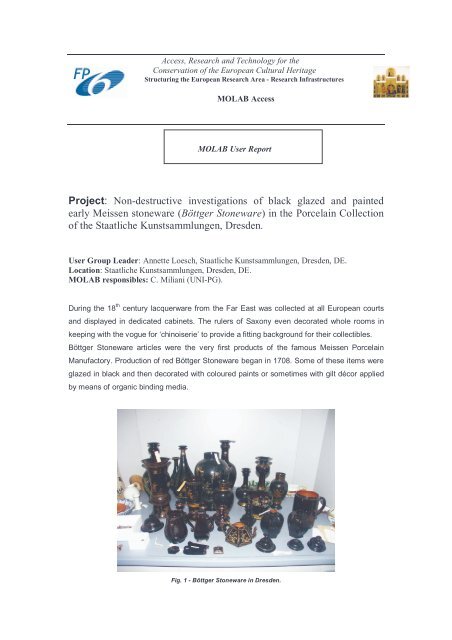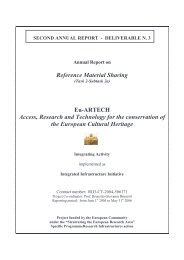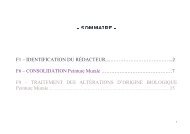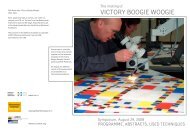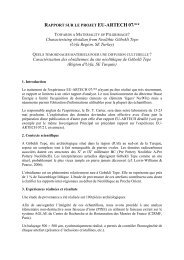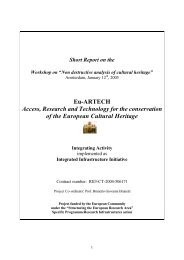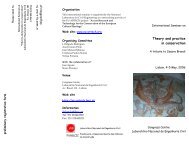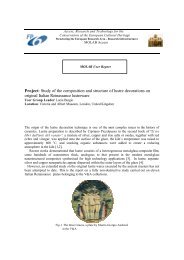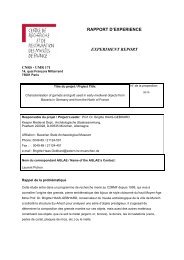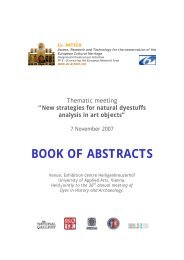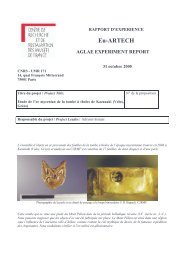User report - Eu-ARTECH
User report - Eu-ARTECH
User report - Eu-ARTECH
Create successful ePaper yourself
Turn your PDF publications into a flip-book with our unique Google optimized e-Paper software.
Access, Research and Technology for the<br />
Conservation of the <strong>Eu</strong>ropean Cultural Heritage<br />
Structuring the <strong>Eu</strong>ropean Research Area - Research Infrastructures<br />
MOLAB Access<br />
MOLAB <strong>User</strong> Report<br />
Project: Non-destructive investigations of black glazed and painted<br />
early Meissen stoneware (Böttger Stoneware) in the Porcelain Collection<br />
of the Staatliche Kunstsammlungen, Dresden.<br />
<strong>User</strong> Group Leader: Annette Loesch, Staatliche Kunstsammlungen, Dresden, DE.<br />
Location: Staatliche Kunstsammlungen, Dresden, DE.<br />
MOLAB responsibles: C. Miliani (UNI-PG).<br />
During the 18 th century lacquerware from the Far East was collected at all <strong>Eu</strong>ropean courts<br />
and displayed in dedicated cabinets. The rulers of Saxony even decorated whole rooms in<br />
keeping with the vogue for ‘chinoiserie’ to provide a fitting background for their collectibles.<br />
Böttger Stoneware articles were the very first products of the famous Meissen Porcelain<br />
Manufactory. Production of red Böttger Stoneware began in 1708. Some of these items were<br />
glazed in black and then decorated with coloured paints or sometimes with gilt décor applied<br />
by means of organic binding media.<br />
Fig. 1 - Böttger Stoneware in Dresden.
Böttger Stoneware objects were designed as precious aristocratic collectors’ items. Initially,<br />
Chinese porcelain and Chinese lacquer work were mimicked, but gradually the products<br />
developed into a more complex synthesis that incorporated the artists’ own Baroque stylistic<br />
elements.<br />
Today Böttger Stoneware is considered extremely rare and is avidly sought after by national<br />
and international collections. The Porcelain Collection Dresden owns by far the largest group<br />
of early Böttger Stoneware worldwide<br />
The inorganic composition of the stoneware without glaze and painting has been investigated<br />
in previous studies [Ullrich 1990; Neelmeijer 2003; ISIS Experimental Report 2003]. But<br />
virtually no information exists about the technology and chemical composition of the<br />
decorative artwork on this glazed stoneware. In its early phase the manufactory faced serious<br />
technical problems when trying to produce coloured glaze decorations by firing. So it was<br />
decided to use pigments bound in organic materials like resins and oils instead (described, for<br />
example, in Johann Melchior Steinbrück’s <strong>report</strong> about the Meissen Manufactory from its<br />
inception up to 1717).<br />
A representative selection of 25 Böttger Stoneware objects were examined through the<br />
MOLAB facilities in July 2006. Two non-invasive methods for the characterisation of inorganic<br />
pigments and for the identification of organic binding media and coatings on the objects were<br />
used, namely Fourier-transform-infrared-spectroscopy (FTIR) and X-ray-fluorescence (XRF).<br />
The objects were examined in the repository of the Porcelain Collection. FTIR was used for<br />
the measurement of 129 points on several objects. For mid-FTIR spectroscopy, the IR beam<br />
was delivered by fibre optic cable placed close to the surface (on the painted décor of the<br />
vessel). Mid-FTIR spectroscopy enabled binders and coatings to be analysed, providing a<br />
reliable classification of the organic polymers in terms of functional groups (lipids, proteins,<br />
terpenes). The findings concerning organic coatings were compared with those of material<br />
samples of known composition, enabling the typical binding media, dyestuffs and lakes to be<br />
identified.<br />
XRF analyses were carried out for identifying pigments by determining their elemental<br />
composition (176 measuring points on 22 objects). The investigations focused on details of<br />
the coloured and gilded décor that had been decided upon beforehand.<br />
The two methods of investigation enabled details of the polychrome and gilt painting to be<br />
analysed non-destructively. From the elements identified by XRF, it was possible to draw<br />
conclusions regarding the pigments, that resulted to be those typical of the period. The FTIR<br />
measurements also showed that organic binders were used.<br />
The findings of the scientific investigations will appear in the forthcoming catalogue of the<br />
Porcelain Collection’s holdings of black glazed Böttger Stoneware. Furthermore, the analytical<br />
results will form the basis for developing long-term conservation strategies for the fragile paint<br />
layer on the glaze of this stoneware.
References<br />
Scientific investigations:<br />
Ullrich, Bernd: Vergleichende Untersuchungen an historischen deutschen und chinesischen<br />
Steinzeugen des frühen 18. Jahrhunderts. – In: Silikattechnik 41 (1990) Heft 10, S. 328-330<br />
Neelmeijer, Christian; Mäder, Michael; Pietsch, Ulrich; Ulbricht, Heike; Walcha, Hans-Martin:<br />
Böttger stoneware – authentic or not? in: Ehrenfried Walther von Tschirnhaus<br />
Gesamtausgabe, ed. by E. Knobloch, Beiband zum Kolloquium aus Anlass des 350.<br />
Geburtstages von E. W. v. Tschirnhaus am 10.4.2001 in Dresden, ed. by D. Hülsenberg,<br />
Verlag der Sächsischen Akademie der Wissenschaften zu Leipzig, 2003, p.29.<br />
See also ISIS Experimental Report, RB number 14022, date July 2003 by the Rutherford<br />
Appleton Laboratory at http://www.isis.rl.ac.uk/isis2003/<strong>report</strong>s/14022.pdf<br />
Crafts (Stoneware):<br />
Loesch, Anette: An schwartz Indianischen und schwartz laquirten rothen Sächß. Porcelain. In:<br />
Sächßisch Lacquirte Sachen. Lackkunst in Dresden unter August dem Starken. Monika<br />
Kopplin und Gisela Haase (Hrsg.), Münster 1998, S. 71-79<br />
Schwartz Porcelain. Die Leidenschaft für Lack und ihre Wirkung auf das europäische<br />
Porzellan, Monika Kopplin (Hrsg.), München 2003.<br />
Loesch, Anette; Schwarm-Tomisch, Elisabeth: “An … schwarz lacquirten rothen sächss.<br />
Porcelain“. Die schwarz glasierten Meissener Steinzeuge aus der Sammlung Augusts des<br />
Starken. In: Keramos 179/180, 2003, S. 61-64.<br />
Kopplin, Monika: La peinture à la laque sur les grès de Böttger et le problème de leur<br />
attribution à Martin Schnell" Lecture at the Sèvres Museum Society, Sèvres, Feb. 1 st , 2005.<br />
Kopplin, Monika: Lacquer Painting on Böttger Stoneware: Three Walzenkrüge and the<br />
problem of attribution to Martin Schnell. In: The International Ceramics Fair & Seminar June<br />
2005, S. 27-37.<br />
Crafts (Furniture):<br />
Miller, Katharina von: das Lackkabinett von Martin Schnell aus dem Kunstgewerbemuseum in<br />
Budapest. Herstellung, Restaurierungsgeschichte, vergleichende Analyse der Werktechnik.<br />
Diplomarbeit Hildesheim, Holzminden, Göttingen 2002.<br />
Kopplin, Monika: Chinois. Dresdener Lackkunst in Schloß Wilaów, Münster 2005.


